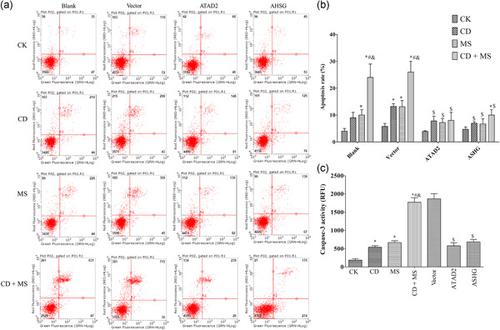当前位置:
X-MOL 学术
›
J. Cell. Physiol.
›
论文详情
Our official English website, www.x-mol.net, welcomes your
feedback! (Note: you will need to create a separate account there.)
Proteomic analysis of underlying apoptosis mechanisms of human retinal pigment epithelial ARPE-19 cells in response to mechanical stretch.
Journal of Cellular Physiology ( IF 4.5 ) Pub Date : 2020-05-21 , DOI: 10.1002/jcp.29670 Fancheng Yan 1 , Meng Gao 2 , Yiyi Gong 3 , Lin Zhang 4 , Nanping Ai 5 , Jingxue Zhang 6 , Yijie Chai 7 , Shen Wu 6 , Qian Liu 6 , Xian Jiang 8 , Haiteng Deng 4 , Wu Liu 9
Journal of Cellular Physiology ( IF 4.5 ) Pub Date : 2020-05-21 , DOI: 10.1002/jcp.29670 Fancheng Yan 1 , Meng Gao 2 , Yiyi Gong 3 , Lin Zhang 4 , Nanping Ai 5 , Jingxue Zhang 6 , Yijie Chai 7 , Shen Wu 6 , Qian Liu 6 , Xian Jiang 8 , Haiteng Deng 4 , Wu Liu 9
Affiliation

|
Our previous study demonstrated mechanical stretch (MS) could induce the apoptosis of retinal pigment epithelial (RPE) cells, but the related mechanisms remained unclear. This study was to characterize the protein expression profile in RPE cell line ARPE‐19 exposed to MS, cytochalasin D (CD; an inhibitor of actin polymerization) or CD + MS at 2‐time points (6, 24 hr; n = 3, at each time point) by using proteomics technique. Our data highlighted that compared with control, ECE1 was continuously downregulated in ARPE‐19 cells treated by MS or CD + MS from 6 to 24 hr. Function and protein–protein interaction network analyses showed ATAD2 was downregulated in all three treatment groups compared with control, but successive upregulation of RPS13 and RPL7 and downregulation of AHSG were specifically induced by MS. ATAD2 was enriched in cell cycle; AHSG was associated with membrane organization; RPS13 and RPL7 participated in ribosome biogenesis. Furthermore, transcription factor CREB1 that was upregulated in MS group at 24 hr after treatment, may negatively regulate ATAD2. The expressions of all crucial proteins in ARPE‐19 cells were confirmed by western blot analysis. Overexpression of ATAD2 and AHSG were also shown to reverse the apoptosis of ARPE‐19 cells induced by MS or CD + MS, with significantly decreased apoptotic rates and caspase‐3 activities. Accordingly, our findings suggest downregulation of ATAD2 and AHSG may be potential contributors to the apoptosis of RPE cells induced by MS. Overexpression of them may represent underlying preventive and therapeutic strategies for MS‐induced retinal disorders.
中文翻译:

蛋白质组学分析人类视网膜色素上皮ARPE-19细胞对机械牵张的潜在凋亡机制。
我们先前的研究表明机械拉伸(MS)可以诱导视网膜色素上皮(RPE)细胞凋亡,但相关机制仍不清楚。这项研究旨在表征暴露于MS,细胞松弛素D(CD;肌动蛋白聚合抑制剂)或CD + MS的RPE细胞系ARPE-19在2个时间点(6、24 hr; n =在每个时间点= 3),使用蛋白质组学技术。我们的数据强调,与对照组相比,在6到24小时内,经MS或CD + MS处理的ARPE-19细胞中ECE1持续下调。功能和蛋白质-蛋白质相互作用网络分析表明,与对照组相比,所有三个治疗组的ATAD2均下调,但MS特异诱导RPS13和RPL7的连续上调以及AHSG的下调。ATAD2丰富了细胞周期。AHSG与膜组织有关。RPS13和RPL7参与了核糖体的生物发生。此外,MS组在治疗后24小时上调的转录因子CREB1可能对ATAD2产生负调控。Western blot分析证实了ARPE-19细胞中所有关键蛋白的表达。还显示ATAD2和AHSG的过度表达可逆转MS或CD + MS诱导的ARPE-19细胞凋亡,并显着降低细胞凋亡率和caspase-3活性。因此,我们的发现表明ATAD2和AHSG的下调可能是MS诱导RPE细胞凋亡的潜在原因。它们的过度表达可能代表MS诱发的视网膜疾病的潜在预防和治疗策略。
更新日期:2020-05-21
中文翻译:

蛋白质组学分析人类视网膜色素上皮ARPE-19细胞对机械牵张的潜在凋亡机制。
我们先前的研究表明机械拉伸(MS)可以诱导视网膜色素上皮(RPE)细胞凋亡,但相关机制仍不清楚。这项研究旨在表征暴露于MS,细胞松弛素D(CD;肌动蛋白聚合抑制剂)或CD + MS的RPE细胞系ARPE-19在2个时间点(6、24 hr; n =在每个时间点= 3),使用蛋白质组学技术。我们的数据强调,与对照组相比,在6到24小时内,经MS或CD + MS处理的ARPE-19细胞中ECE1持续下调。功能和蛋白质-蛋白质相互作用网络分析表明,与对照组相比,所有三个治疗组的ATAD2均下调,但MS特异诱导RPS13和RPL7的连续上调以及AHSG的下调。ATAD2丰富了细胞周期。AHSG与膜组织有关。RPS13和RPL7参与了核糖体的生物发生。此外,MS组在治疗后24小时上调的转录因子CREB1可能对ATAD2产生负调控。Western blot分析证实了ARPE-19细胞中所有关键蛋白的表达。还显示ATAD2和AHSG的过度表达可逆转MS或CD + MS诱导的ARPE-19细胞凋亡,并显着降低细胞凋亡率和caspase-3活性。因此,我们的发现表明ATAD2和AHSG的下调可能是MS诱导RPE细胞凋亡的潜在原因。它们的过度表达可能代表MS诱发的视网膜疾病的潜在预防和治疗策略。











































 京公网安备 11010802027423号
京公网安备 11010802027423号